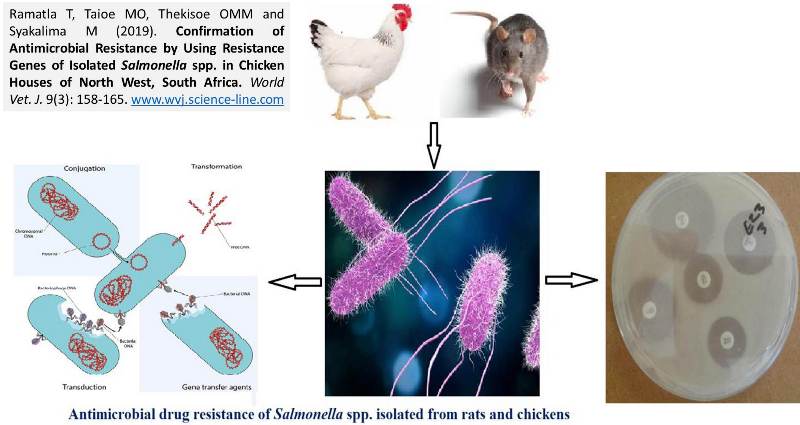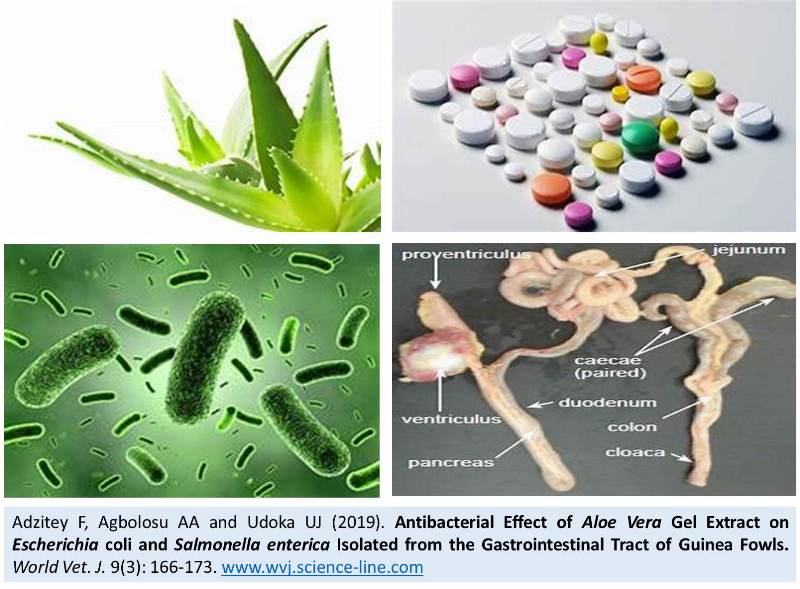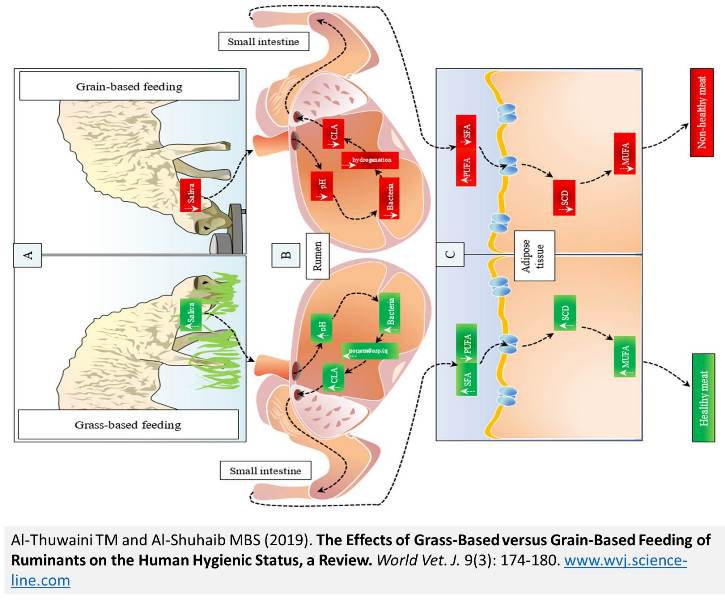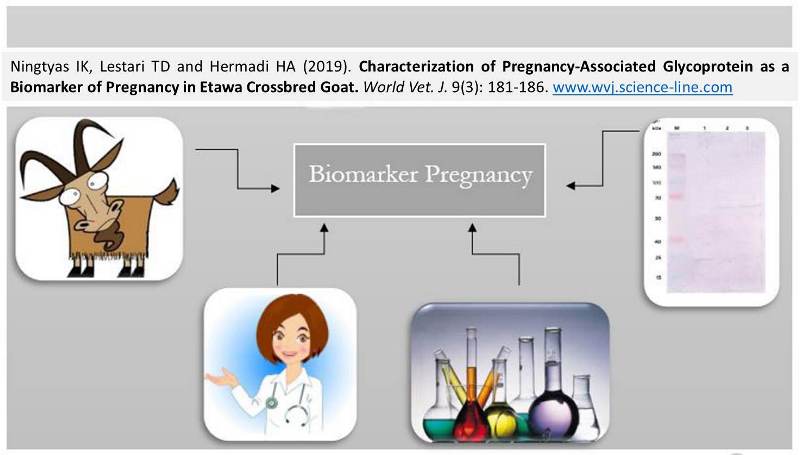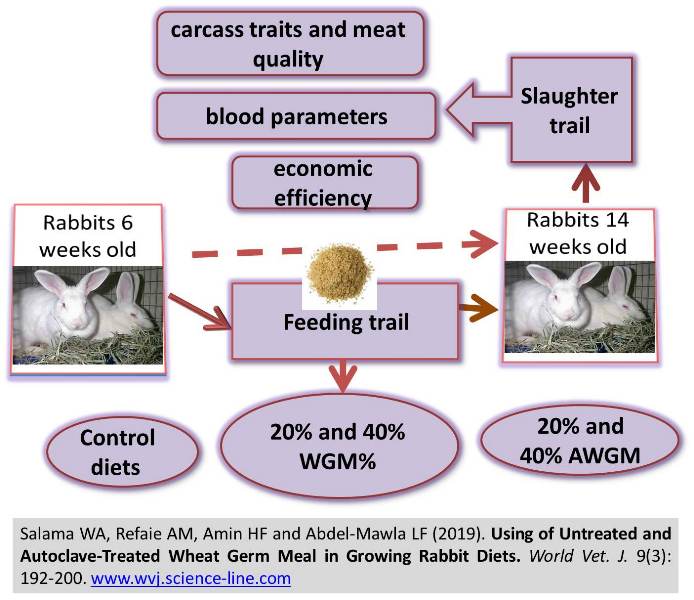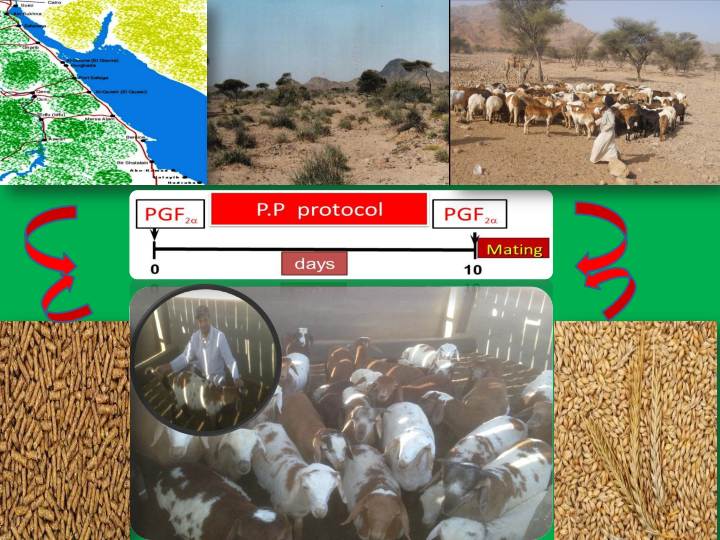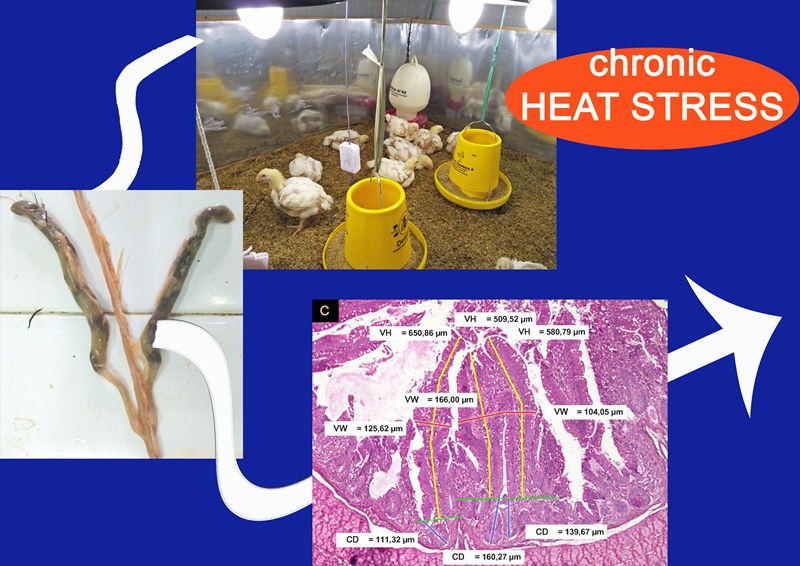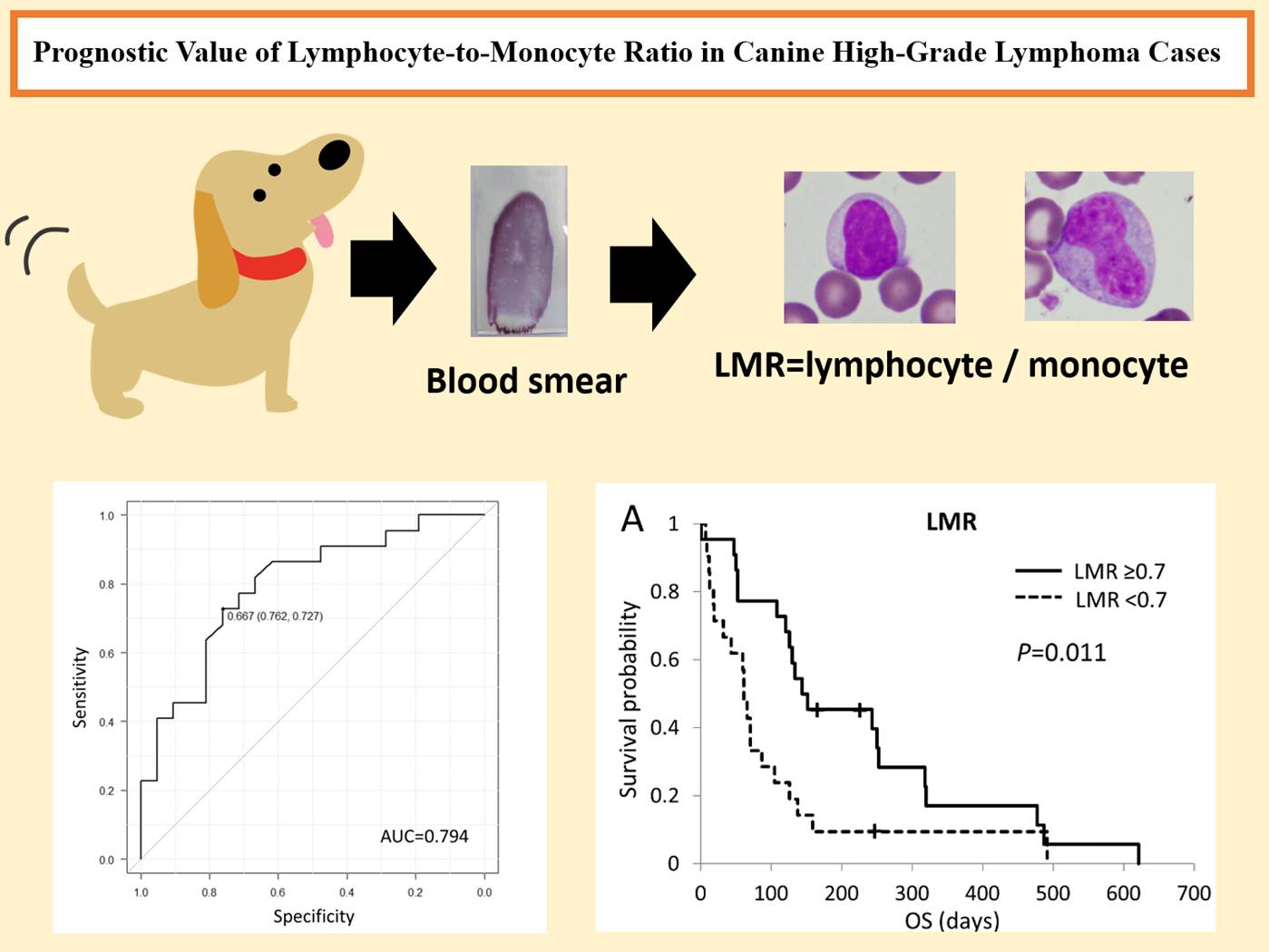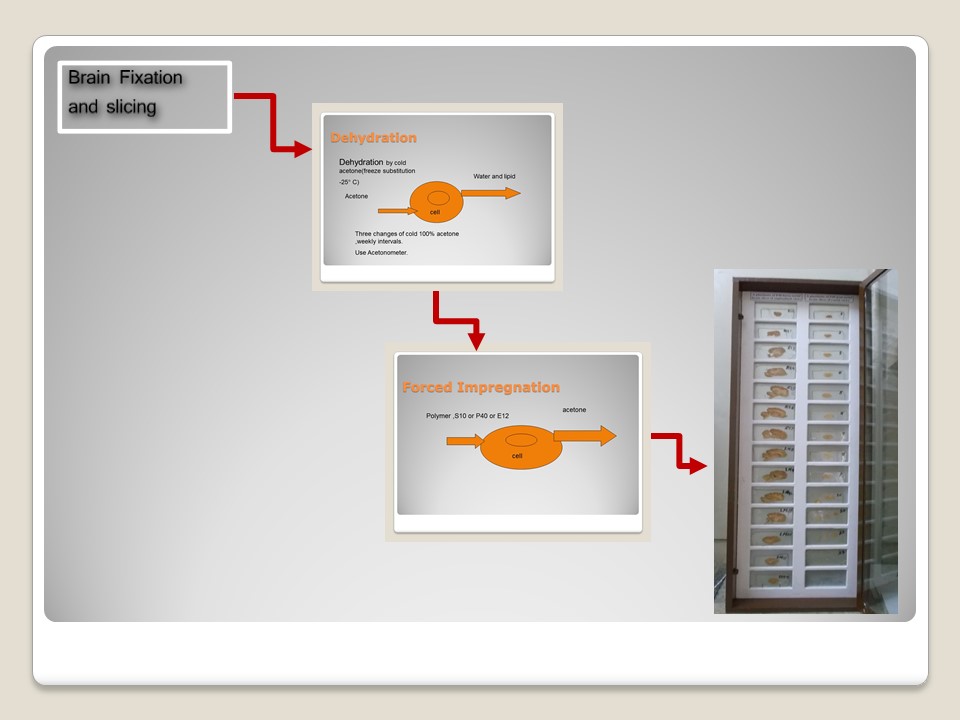Previous issue | Next issue | Archive
![]() Volume 9 (3); September 25, 2019 [Booklet, covers 1 & 2] [EndNote XML for Agris]
Volume 9 (3); September 25, 2019 [Booklet, covers 1 & 2] [EndNote XML for Agris]
Confirmation of Antimicrobial Resistance by Using Resistance Genes of Isolated Salmonella spp. in Chicken Houses of North West, South Africa.
Ramatla T, Taioe MO, Thekisoe OMM and Syakalima M.
World Vet. J. 9(3): 158-165, 2019; pii:S232245681900020-9
DOI: https://dx.doi.org/10.36380/scil.2019.wvj20
ABSTRACT
The widespread use of antibiotics for treatment of bacterial infections and growth promotion in the poultry industry has effectively increased antibiotic resistance around the world. Antibiotics resistance can be caused by different mechanisms and can be determined through phenotypic and molecular methods. The aim of the present study was to determine the occurrence of antibiotic resistance in Salmonella serovars isolated from layer chickens and rats in poultry houses. Phenotypic testing of antimicrobial resistance was performed using the Kirby-Bauer disc diffusion method. Furthermore, molecular evaluations and PCR assay were conducted for detecting resistance genes and class 1 integrons. A total of 144 Salmonella isolates (68 from rats and 46 from chickens) serovars were assessed. Evaluation of phenotypic resistance patterns demonstrated that Salmonella isolates have the highest antibiotic resistance for rifampicin (100%) followed by tetracycline (68%), ciprofloxacin (48%), sulphonamides (42%), chloramphenicol (39%), nalidixic acid (33%), ampicillin (28%), cephalothin (18%), streptomycin (18%), amoxicillin-clavulanic acid (6%), enrofloxacin (5%), and gentamicin (4%). Some Salmonella serovars revealed multi-drug resistance for up to four different antibiotics. According to PCR results, all the tested resistant gene markers (tet, cat, blaTEM, sul, qnrA, and aadA) were detected from the Salmonella isolates. The study further confirmed that 68% of Salmonella isolates were harboring class 1 integrons and the majority of the isolates (n=52) which were harboring these genes were recovered from the rats. The results of the present study provided that the Salmonella spp. isolated from chickens and rats in poultry houses, exhibited significant antibiotic resistance. Moreover, the current research ultimately highlights the importance of rats as carriers of antibiotic-resistant bacteria and the risk of transmission to chickens and humans.
Key words: Antibiotic resistance pattern, Class 1 integrons, Resistance genes, Salmonella serovars
[Full text-PDF] [XML] [Import into EndNote] [Google Scholar]
Antibacterial Effect of Aloe Vera Gel Extract on Escherichia coli and Salmonella enterica Isolated from the Gastrointestinal Tract of Guinea Fowls.
Adzitey F, Agbolosu AA and Udoka UJ.
World Vet. J. 9(3): 166-173, 2019; pii:S232245681900021-9
DOI: https://dx.doi.org/10.36380/scil.2019.wvj21
ABSTRACT
Aloe vera has a long history as a medicinal plant with diverse therapeutic applications. This study was conducted to assess the antibacterial effect of Aloe vera gel extract against Escherichia coli and Salmonella enterica isolated from the gastrointestinal tract (GIT) of guinea fowls. The conventional method was used for the isolation of Escherichia coli and Salmonella enterica. The antibacterial activity of Aloe vera gel extracts (50, 100 and 200 mg/ml) and standard antibiotics were evaluated using the disk diffusion method. The prevalence of Escherichia coli in the GIT of the guinea fowls was 100% (15/15). All the Escherichia coli were susceptible to ciprofloxacin. At 48h and 72h of incubation, all the Escherichia coli were susceptible to gentamicin but not at 24h. Inhibition zones using the Aloe vera gel extract ranged from 7.87-12.23mm (50 mg/ml), 8.53-17.23mm (100 mg/ml) and 7.43-10.67mm (200 mg/ml) for Escherichia coli. Also, antibacterial test for Escherichia coli using the Aloe vera gel extract revealed an inhibition zone of 9.10-12.23mm for Escherichia coli isolate GIT1, 7.8-8.57mm for Escherichia coli isolate GIT2 and 7.43-17.23mm for Escherichia coli isolate GIT7. The prevalence of Salmonella enterica in the GIT of the guinea fowls was 40% (6/15). All Salmonella enterica were susceptible to gentamicin. At 48h and 72h of incubation, all the Salmonella enterica were susceptible to suphamethoxazole/trimethoprim and tetracycline but not at 24h. Inhibition zones using Aloe vera gel extract ranged from 7.13-12.57mm (50 mg/ml), 4.2-6.7mm (100 mg/ml) and 0-9.23mm (200 mg/ml). Furthermore, antibacterial test for Salmonella enterica using the Aloe vera gel extract revealed an inhibition zone of 5.3-12.57mm for Salmonella enterica isolate GIT9, 0-7.8mm for Salmonella enterica isolate GIT10 and 4.2-9.0mm for Salmonella enterica isolate GIT15. The study revealed that Aloe vera gel extract possessed antibacterial properties. Therefore, it can be added to the feed of guinea fowls as a prophylactic to reduce bacterial infections.
Key words: Aloe vera, Antibiotics, Escherichia coli, Gut, Salmonella enterica
[Full text-PDF] [XML] [Import into EndNote] [Citations on Google Scholar]
The Effects of Grass-Based versus Grain-Based Feeding of Ruminants on the Human Hygienic Status, a Review.
Al-Thuwaini TM and Al-Shuhaib MBS.
World Vet. J. 9(3): 174-180, 2019; pii:S232245681900022-9
DOI: https://dx.doi.org/10.36380/scil.2019.wvj22
ABSTRACT
Ruminant meat quality is one of the important factors contributing to the recent spreading of several diseases, such as obesity, cancer, and cardiovascular problems, which have increased predominately. Feeding regiment plays an important role in the determination of the composition of fatty acids and meat quality in ruminants. This review aims to highlight the main factors that lie behind the variability of ruminant meat quality and its effect on human being’s health. The reduction in grass-feeding decreases saliva levels in the ruminants, which has several consequences on the rumen, including a reduction in pH level, along with a reduction in the microorganism activities and conjugated linoleic acid levels. In adipose tissues, the expression of the stearoyl-CoA desaturases gene is negatively affected by the decreased conjugated linoleic acid levels in the rumen, which leads to a decreased transformation of saturated fatty acids to monounsaturated fatty acids. Therefore, the lower monounsaturated fatty acids and the parallel increase in the proportion of saturated fatty acids in the consumed meat can be associated with some human diseases. Thus, the present study provided a molecular explanation for the superiority of grass-based feeding in ruminants raised at pasture in term of production of meat with a healthier quality for consumers than those raised on grains.
Key words: Grain; Grass, Human disease, Ruminant meat, SCD enzyme
[Full text-PDF] [XML] [Import into EndNote] [Citations on Google Scholar]
Characterization of Pregnancy-Associated Glycoprotein as a Biomarker of Pregnancy in Etawa Crossbred Goat.
Ningtyas IK, Lestari TD and Hermadi HA.
World Vet. J. 9(3): 181-186, 2019; pii:S232245681900023-9
DOI: https://dx.doi.org/10.36380/scil.2019.wvj23
ABSTRACT
Pregnancy-Associated Glycoprotein (PAG) is secreted by the placenta, which is produced in mononucleate and binucleate trophoblast cells. The current research was conducted to find out a substance for diagnosing early pregnancy in Etawa crossbred goats. Six Etawa crossbred goats (not pregnant, three months pregnant and four months pregnant) were subjected in the present study from Livestock Government Institution Breeding in Singosari, Malang. The research methods consisted of sample collection, identification PAG with sodium dodecyl sulfate–polyacrylamide gel electrophoresis, the determination of concentration with Biuret method and specificity test with Western Blot assay. The obtained results showed that the molecular weight of PAG from pregnant Etawa crossbred goats was 55.85 kDa. The average concentrations of PAG in the goats of non-pregnant, three months pregnant, and four months pregnant were 1.83±2.98, 3.79±2.72 and 4.36±2.63, respectively. The results of the specificity test with the Western Blot molecular revealed a molecular mass of PAG was 55 kDa. The findings of the present study demonstrated PAG in Etawa crossbred goats can be used as an indicator of pregnancy.
Key words: Biomarkers, Etawa crossbred, PAG, Pregnancy
[Full text-PDF] [XML] [Import into EndNote] [Citations on Google Scholar]

Research Paper
Incretin Mimetics Vildagliptin and Exenatide Improve Pedicle Skin Flap Survival in Rats.
Danilenko LМ, Tarasova AP, Pokrovskiy MV, Trunov KS, Stepenko YV, Artyushkova EB and Gudyrev OS.
World Vet. J. 9(3): 187-191, 2019; pii:S232245681900024-9
DOI: https://dx.doi.org/10.36380/scil.2019.wvj24
ABSTRACT
Hypoxia and tissue ischemia are the leading factors in the alteration of tissues in many pathological conditions. Prevention and reversion of the effects of local ischemia, which develops during various surgical interventions, is an actual problem of modern medicine. The aim of the present study was to investigate the effect of exenatide and vildagliptin on the survival rate of an isolated pedicle skin flap in sixty adults Wistar rats. Simulation of a pedicle skin graft was performed on the second day of the experiment. After anesthesia under aseptic conditions, a skin graft was cut out: isolated in a plastic bag, the edges of the skin were stitched with interrupted sutures (nylon 3/0). Rats were divided into six groups: control group, exenatide group (10 µg/kg/day subcutaneously for nine days after surgery), vildagliptin group (0.2 mg/kg/day intraperitoneally for nine days after surgery) and pentoxifylline group (100 mg/kg/day intravenously, two hours before the surgical intervention). In the other two groups, glibenclamide (5 mg/kg) were administered before injection of incretin mimetics. On the third, seventh and tenth day, area of the surviving tissue was measured. Subsequently, the survival rate of the skin graft was calculated. The area of the surviving tissue in exenatide and vildagliptin group was 1.5 and 1.7 times more compared to the control group, respectively. Preliminary blockade of ATP-dependent potassium channels by glibenclamide eliminated the protective effect of exenatide and vildagliptin. The increase in the survival of ischemic tissues using exenatide and vildagliptin has been experimentally proved. The current study confirmed the important role of ATP-dependent potassium channels in dermatoprotective properties of incretin mimetics.
Key words: Dermatoprotective properties, Еxenatide, Ischemia, Pedicle skin graft, Vildagliptin.
[Full text-PDF] [XML] [Import into EndNote] [Citations on Google Scholar]
Use of Untreated and Autoclave-Treated Wheat Germ Meal in Growing Rabbit Diets.
Salama WA, Refaie AM, Amin HF and Abdel-Mawla LF.
World Vet. J. 9(3): 192-200, 2019; pii:S232245681900025-9
DOI: https://dx.doi.org/10.36380/scil.2019.wvj25
ABSTRACT
The present study was intended to investigate the influence of using 20% and 40% treated or untreated wheat germ meal in growing New Zealand rabbit diets. A total of 75 weaned New Zealand White rabbits aged six weeks old, with an average initial weight of 659.60±18.84g were divided into five groups with five replicates in each group (three rabbits per replicate). The first group was fed on a basal diet (T1), second and third groups received diets containing Wheat Germ Meal (WGM), as replacement of soybean meal protein, at levels of 20% and 40% and were labeled as T2, T3, respectively. Fourth and fifth groups were fed with 20% and 40% autoclave-treated autoclaved WGM (T4 and T5, respectively). The trial was continued until 14 weeks of age. The present study was evaluated growth performance, blood parameters, carcass traits, meat quality in different groups and also economic efficiency was calculated. There were insignificant differences in terms of live weight, daily weight gain, carcass weight and dressing percentages among rabbits in groups of T1, T2, and T4. Rabbits in the group of T4 achieved the best feed conversion ratio. Digestion coefficients of crude protein, crude fiber, ether extract, nitrogen-free extract, and nutritive value in terms of digestible crude protein, total digestible nutrition, and digestible energy did not significantly differ between T1 and T4. However, these factors significantly decreased in T3 and T5 compared to T1. Plasma total protein and globulin significantly increased in rabbits of T2 and T4 compared to those fed in T1 group. A significant decrease in total cholesterol and total lipid for rabbits in groups of T4, T5, and T2 was observed. Moreover, rabbits fed on T4 or T2 diets had the highest economic efficiency. Conclusively, the untreated or autoclaved WGM can be used in growing rabbit diets up to 20% for replacing the soybean meal protein, which caused low feed costs without adverse effects on the growth performance of rabbits.
Key words: Rabbits, Soybean meal, Wheat germ meal
[Full text-PDF] [XML] [Import into EndNote] [Citations on Google Scholar]
Productive Characteristics and Reproductive Responses to Estrus Synchronization and Flushing in Abou-Delik Ewes Grazing in Arid Rangelands in Halaieb - Shalateen - Abouramad Triangle of Egypt.
Farrag B.
World Vet. J. 9(3): 201-210, 2019; pii:S232245681900026-9
DOI: https://dx.doi.org/10.36380/scil.2019.wvj26
ABSTRACT
There are a few reports about the reproductive aspects or uses of both of flushing and estrus synchronization in Abou-Delik ewes grazing in the South Eastern zone of Egypt. Thirty-three Abou-Delik ewes were allocated to three experimental groups (n = 11 in each) to study the effects of estrus synchronization and flushing on reproductive responses and productive characteristics under arid conditions of South Eastern zone of Egypt. Group one served as control represent the system dominant in the area (without estrus synchronization and flushing ration). Ewes in group two were estrous synchronized with two doses of PGF2α, 10 days apart without flushing ration. Ewes in group three were estrous synchronized just like the second group and received 300g of barley grain/head/day as flushing meal for three weeks before the start of breeding season. All ewes were grazed Panicum turgidum (natural vegetation dominant in the area) for eight hours daily. Results showed that, the percentage of estrus exhibition in group three reached 100%, while the lowest percentage was observed in group one (81.82 %). Estrus activity signs in synchronized groups, occurred in 70 and 81.81% during the first 48 h after the second dose of PGF2α, for groups two and three respectively, compared to control group (22.22 %). The onset of estrus was earlier in synchronized groups than control group. Duration of estrus did not differ significantly. Estrus intensity in group three was higher (P< 0.05) compared to the other groups. Conception and lambing rates were 100% in group three. Third group showed the highest insignificant litter size that was 18% higher than the other groups. The overall mean of birth weight, weaning weight and average daily gain of Abou-Delik lambs were 2.91, 16.89 and 0.116 kg, respectively. There is no significantly effect on concentrations of plasma progesterone among groups. While there were significant differences between sampling periods. In conclusion, under grazing on arid rangelands conditions in the South Eastern zone of Egypt, using flushing and/or estrus synchronization can be useful to improve reproductive and productive characteristics of Abou-Delik sheep.
Key words: Abou-Delik sheep, Estrus synchronization, Flushing, Productive performance, Rangelands, Reproduction
[Full text-PDF] [XML] [Import into EndNote] [Citations on Google Scholar]
Histopathological Alterations of Ceca in Broiler Chickens (Gallus gallus) Exposed to Chronic Heat Stress.
Adji AV, Plumeriastuti H, Ma’ruf A and Legowo D.
World Vet. J. 9(3): 211-217, 2019; pii:S232245681900027-9
DOI: https://dx.doi.org/10.36380/scil.2019.wvj27
ABSTRACT
Heat stress has been found to cause adverse effects on small intestinal microstructure, but little is known about its impact on chicken’s cecum. In this research, the histopathological alterations of broiler chicken’s cecum following chronic heat stress were evaluated. 20 broiler chickens were randomly divided into control group and treatment group containing 10 replicates, respectively. Both groups were reared under standard conditions until 21 days of age. From day 22 to day 42, the control group was kept at 24-28⁰C as well as relative humidity of 40-55%, while the treatment group was exposed to high temperature of 36-40⁰C and relative humidity of 45-65% for eight hours per day. At the end of the period, proximal part of each chicken’s cecum was collected and made into histopathological slides with Hematoxylin and Eosin staining. Villus height, villus width, crypt depth, villus surface area, and villus height to crypt depth ratio were examined from 10 villi per replicate. Results analysis revealed that chronic heat stress profoundly (P<0.05) reduced the crypt depth. Insignificant (P>0.05) changes of the villus despite the long-term heat exposure might imply that the damage is at its early phase. In conclusion, chronic heat stress can produce morphological alterations in the ceca of broiler chickens, though requiring longer duration due to cecum’s durability.
Key words: Broiler chicken, Cecum, Heat stress, Intestinal morphology
[Full text-PDF] [XML] [Import into EndNote] [Citations on Google Scholar]
Prognostic Value of Lymphocyte-to-Monocyte Ratio in Canine High-Grade Lymphoma Cases.
Tagawa M, Shimbo G, Matsumoto K and Miyahara K.
World Vet. J. 9(3): 218-229, 2019; pii:S232245681900028-9
DOI: https://dx.doi.org/10.36380/scil.2019.wvj28
ABSTRACT
The Lymphocyte-to-Monocyte Ratio (LMR) has been described as a useful prognostic marker for human patients with various cancers and dogs with diffuse large B-cell lymphoma. The objective of this study was to determine whether the LMR could predict disease outcome as measured by the Time To Progression (TTP) and Overall Survival (OS) of dogs with different types of high-grade lymphoma. The medical records of 43 dogs diagnosed with high-grade lymphoma at the Veterinary Medical Center of Obihiro University of Agriculture and Veterinary Medicine between 2013 and 2018, were retrospectively analyzed. Receiver Operating Characteristic (ROC) curve analysis was used to determine the optimal LMR cutoff values. The prognostic influence of the LMR and other clinicopathological data on TTP and OS was studied by Kaplan-Meier curves. To identify the independent prognostic factors, univariate and multivariate Cox proportional analyses were used. The optimal cutoff value of the LMR was 0.7, which corresponded to the maximum sensitivity (0.727) and specificity (0.762) of the LMR for predicting the median days of OS with ROC analysis (area under the curve, 0.794). Log-rank tests showed that dogs with a high LMR had significantly longer TTP and OS than dogs with a low LMR. Moreover, immunophenotype, body weight, treatment regimen and response to treatment were significantly associated with TTP and OS. In multivariate analysis, treatment and response to treatment were independent risk factors for TTP. Moreover, the LMR, treatment regimen and response to treatment were independent predictors of OS.
Key words: Dog, Lymphocyte to monocyte ratio, Lymphoma, Prognosis
[Full text-PDF] [XML] [Import into EndNote] [Citations on Google Scholar]
Computed Tomography Scan and Polyester resin 40 Plastination Technique: Teaching Aids to Illustrate Anatomical Structure of Donkey Brain.
Mohamed ShKhA, El-Behery EI and Mahdy EAA.
World Vet. J. 9(3): 230-240, 2019; pii:S232245681900029-9
DOI: https://dx.doi.org/10.36380/scil.2019.wvj29
ABSTRACT
The present study investigated the collaboration between the plastinated sagittal sections and computed tomography (CT) images of the donkey brain. Four adult healthy donkeys of both sexes from native breeds were analyzed. The animals were sedated with a combination of xylazine and ketamine. The donkeys were positioned in sternal recumbency during CT brain examination and contiguous sagittal 3 mm thick slices of the head were obtained. Polyester resin 40 (P40) technique for the brains were done through five main steps including fixation, slicing, dehydration, forced impregnation and light-curing of brain glass chambers by UVA light source. Furthermore, a survey was conducted using questionnaires involving second-year veterinary medical students of anatomy department, Zagazig University to compare the educational capacity of CT brain images and P40 plastination of brain slices. 52% of students voted that using of brain sheeted slices are much better, 38% prefer to learn both parallel to each other. The obtained results revealed that both the plastinated brain sections and the CT images portrayed a combination of many complex neuroanatomical structures that provide an excellent aid for researchers in educational and diagnostic purposes. In addition, the plastinated brain serves as a good tool for the interpretation of CT images.
Key words: Brain, CT, Donkey, Plastination, Polyester resin 40
[Full text-PDF] [XML] [Import into EndNote] [Citations on Google Scholar]
Previous issue | Next issue | Archive
![]() This work is licensed under a Creative Commons Attribution 4.0 International License (CC BY 4.0).
This work is licensed under a Creative Commons Attribution 4.0 International License (CC BY 4.0).



